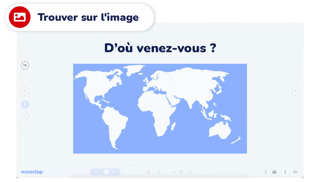"How to actually make your students want to learn?" This is a question that could interest many teachers! One solution is to create an environment conducive to learning by using icebreakers.
Icebreaker activities will be your best ally in fighting against monotonous classes where students are too passive. Here, the teacher or trainer puts on his facilitator hat and uses class time optimally by introducing activities that engage learners. Find out why and how in our article!
What is an icebreaker?
Icebreakers are short group activities ranging from a few minutes to a few hours. They are designed to discuss, question, share ideas, experiences, feelings, etc. (depending on the nature of the activity chosen) with other students as well as with the teacher. They are also an excellent way to introduce a course theme.
Icebreakers are often used at the beginning of a course to "break the ice" and facilitate initial contacts between students in the same class and/or between students and teachers.
However, these activities can be implemented at any time during the year, as soon as the group dynamics fall or class participation weakens.
Some activities are also achievable during a virtual class, but we highly recommend doing them in person for more dynamism.
Why use icebreakers?
- To get to know your students
- To create a trusting and friendly environment conducive to memory anchoring
- To make communication more fluid
- To let students speak. It is also a good way to help them fit in (especially for newcomers)
- To engage and bring new energy to your class
- To bring out collective intelligence and foster creativity
- To learn (from others) while having fun
Before implementing these icebreakers, don't forget to question yourself about the objectives sought. Are you trying to:
- Get to know each other
- Introduce a new theme
- Put theoretical concepts into practice
- Tap into your students' imagination
- Gather their point of view?
Define your objectives beforehand, and don't lose sight of them: they will help you build your activity.
One last thing: avoid activities that require revealing information that could be uncomfortable for some students. Remember that these icebreakers should be used to create a positive framework and/or introduce a concept or chapter in a more playful way!
10 Icebreakers to Use in Your Classroom
- To get to know each other:
Icebreaker #1: The Map
Time: 10 min.
Organisation: Use an interactive online tool (Wooclap, Kahoot!, Mentimeter, etc.) and ask your students to connect via their computer or smartphone.
Principle: Start with a simple question to get to know your class, for example: "Where are you from?". Your students will respond directly on the application, and you will be able to see in real time the cities and countries represented on the map.
Objective: Show that you are interested in your students, encourage discussion, and even allow students to establish similarities between each other, a great thing for newcomers!
Icebreaker #2: The 3 "P's"
Time: 20 min.
Organisation: Divide your class into sub-groups of 3-4 students.
Principle: Ask the students to share 3 pieces of information about themselves that will allow their classmates to get to know them better: a personal element, information about their academic and/or professional background, and a personality trait.
Objective: Introduce oneself to classmates, promote integration, and create a relaxed environment in the classroom.
Icebreaker #3: The Bingo
Time: 30 min.
Organisation: Before the start of the class, create small paper or cardboard boards with 6 criteria. For example: "I speak Italian", "I have traveled to Iceland", "I play tennis", etc.
Principle: Once in class, distribute these boards to each of your students and ask them to move around the room and find a classmate who meets one or more of the criteria. For each corresponding affirmation, the student checks a box. The first to check all 6 boxes wins the game.
Objective: Give students the opportunity to get to know each other and create a climate of trust in the classroom.
Icebreaker #4: The Desert Island
Time: 15/20 min.
Organisation: Use an online voting tool (Wooclap, Kahoot!, Mentimeter, etc.) and ask your students to connect via their computer or smartphone.
Principle: Ask the following question "You are stranded on a desert island; you can only choose 4 items from these, which ones do you take?". Your students will then have to choose from the items you have listed (for example: "knife", "tent", "flashlight", "sunscreen", etc.). Give them 2/3 minutes to make their choice. Then, analyse the responses and exchange ideas around them.
Objective: Encourage argumentation among your students while allowing them to present ideas and discuss with each other.
This activity can also be carried out in small groups if the number of students in your class is too large.
- To introduce a concept:
Icebreaker #5: The Expectations
Time: 10 min.
Organisation: Verbally or using an online tool like "word cloud."
Principle: Ask the question, "What are your expectations for this course?" Give them a few minutes to answer, then collect the students' responses.
Objective: This exercise will allow you to communicate the pedagogical objectives, program, and themes covered in this course in a more playful way.
Icebreaker #6: The Word Cloud
Time: 10 min.
Organisation: Use an online tool such as "word cloud" (Wooclap or Mentimeter offer this functionality, among others).
Principle: Ask the following question, "Tell me what comes to mind when you think of..." Complete the sentence with the theme of your new chapter. For example, "What concepts, notions, or ideas do you associate with the word 'Environment'?" Let the word cloud form with the live responses from students. You can then react and draw the 3 main trends. Don't hesitate to question a student who has written a word that catches your attention, so that they can explain and argue.
Objective: This is a good way to introduce a chapter while assessing the level of knowledge of your audience beforehand. You can thus more easily adapt your pace and the degree of difficulty of your course!
- To test students' knowledge:
Icebreaker #7: Pick Your Side
Time: 20 min.
Organisation: No prior organisation needed.
Principle: Describe a situation related to the course you just taught. Give two possible answers and ask your students to move to the left or right side of the classroom based on the option they choose. Then ask one person from each group to explain why they chose that side.
Objective: To discuss, debate and learn to argue. It is also a good way to remember the final answer and therefore anchor the knowledge.
- Throughout the year:
Icebreaker #8: The End of the Week
Time: 5-10 minutes
Organisation: Use a quiz or word cloud tool.
Principle: Let's say your class is on Friday afternoon. Start each of your classes with the question "How was your week?" Then, comment on the responses that appear gradually in your tool.
Objective: Show interest in your students. Solve problems. Or: create a climate of trust conducive to learning for the rest of the session.
Icebreaker #9: The "How you doin'"
Time: Between 5 and 10 minutes.
Organisation: Use a word cloud tool.
Principle: Create the following question in your favorite tool: "How are you doing?" Then, ask your students to type in words that represent how they feel, all anonymously of course.
Objective: To discuss, show consideration and availability for your students, identify potential issues in some students, and offer to discuss them during or at the end of class in private. This question, in addition to creating a positive and caring environment, is crucial today as student well-being is a crucial issue, and students need a teacher they can rely on.
Icebreaker #10: The Weekend
Time: 5 min.
Organisation: Can be done orally.
Principle: Ask your students the following question: "What are your plans for the weekend?".
Objective: Show interest, discuss, create a relaxed atmosphere before starting the class, etc.
Why you should use icebreakers in your classes...
By using icebreakers, you allow your students to feel comfortable in your classroom. By enabling them to discuss, debate, share their opinions, or simply express themselves - whether it's related to the course or not - your students will be more confident, more likely to anchor their knowledge, and much happier to attend your classes!
In this way, you position yourself not as a simple teacher, but as a facilitator ready to explore all possibilities to ensure the success of your learners!

 by:Jeanne Aimerie on: March 2, 2023
by:Jeanne Aimerie on: March 2, 2023
-2.png)
